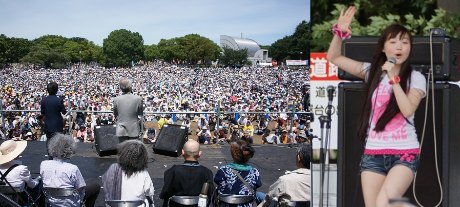Japan's nuclear debate has intensified considerably with the restart of reactors. Weekly protests at the prime minister's residence have been supplemented by the biggest rally so far and a huge petition.
Organisers claimed that 170,000 supporters of 'Sayonara Nukes' met at Yoyogi Park in Tokyo on 16 July. Although other reports put the size of the crowd at around 100,000, even this figure is still some 40,000 beyond the previous largest rally against nuclear power, held in September 2011. Good weather no doubt helped to boost the size of the event as well as the enjoyment of pop performances that followed speeches by the writers and musicians that spearhead the movement.
The same artists have organised a petition expressing an 'emotionally fuelled' request for a 'natural energy society' and have so far gained exactly 7,481,365 signatures towards their stated goal of 10 million. On 12 July this was presented to Takahiro Yokomichi, the speaker of the Diet lower house.
 |
| Organisers took turns addressing the huge crowd - with numerous support acts in Tokyo's Yoyogi Park on 16 July |
Another manifestation of this popular and public movement is a protest each Friday at the official residence of prime minister Yoshihiko Noda. A month ago 45,000 people were drawn to this regular event demanding Noda abandon the idea of restarting any reactors.
In response, Noda's blog has carried articles like one entitled Listening carefully to a range of views. It elaborated on his recent trip to Fukushima prefecture and the qualities displayed by people there as they work to maintain social bonds and re-establish normality. "Whether it be decontamination, managing people's health, ensuring food safety and peace of mind, the reopening of schools and hospitals, or other matters, the responses to the issues facing Fukushima's disaster areas are still only midway to completion," Noda wrote.
He said he had heard "the voices of the large number of people expressing anti-nuclear sentiments... And I also hear the voices of people who are greatly worried about the possibility of rolling blackouts and drastic energy saving measures, including the elderly in elderly care homes, shop owners, and people employed at small- and medium-sized enterprises."
"We also have the hard fact that the restart of the unit 3 reactor at the Ohi nuclear power plant has enabled relaxation of the energy-saving target for the Kansai area to 10%. What we should do now is vigilantly ensure safety, taking all possible means to do so."
Ohi 3 restarted on 5 July and is now back at full power operation, producing 1127 MWe for industrial and heavily populated Kansai. Unit 4 at the plant has also been restarted and is steadily increasing power.
The next unit expected to come online is Ikata 3. The stress test report for this reactor has been reviewed by the Nuclear and Industrial Safety Agency and passed on to the Nuclear Safety Commission for its approval. It then needs approval from ministers, from local governments finally from the national government. The other 18 stress test reports that have been submitted to NISA so far remain at the review stage.
In the meantime, Japan's power policy is under fundamental review. A white paper said in October 2011 that the country's use of nuclear power would be reduced as much as possible from the pre-Fukushima accident levels of about 30%, and away from the pre-Fukushima policy of expansion to 40%. The updated policy set is expected soon.
Researched and written
by World Nuclear News




_53514_33880.jpg)


_91467.jpg)





